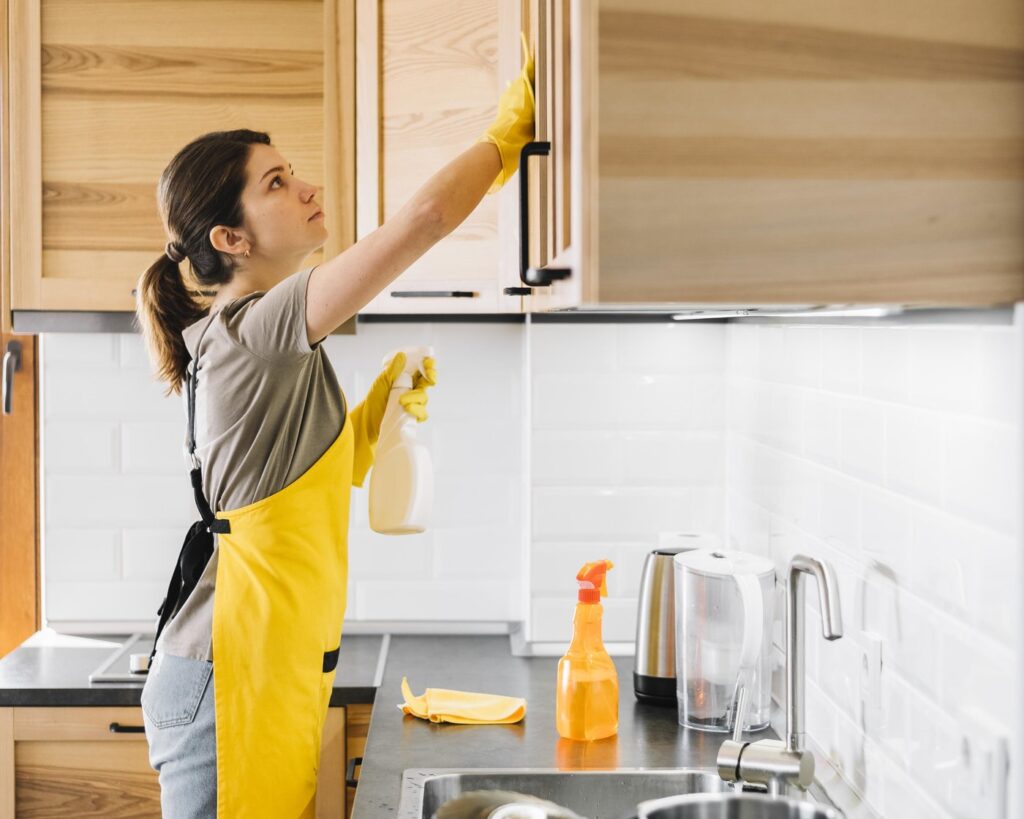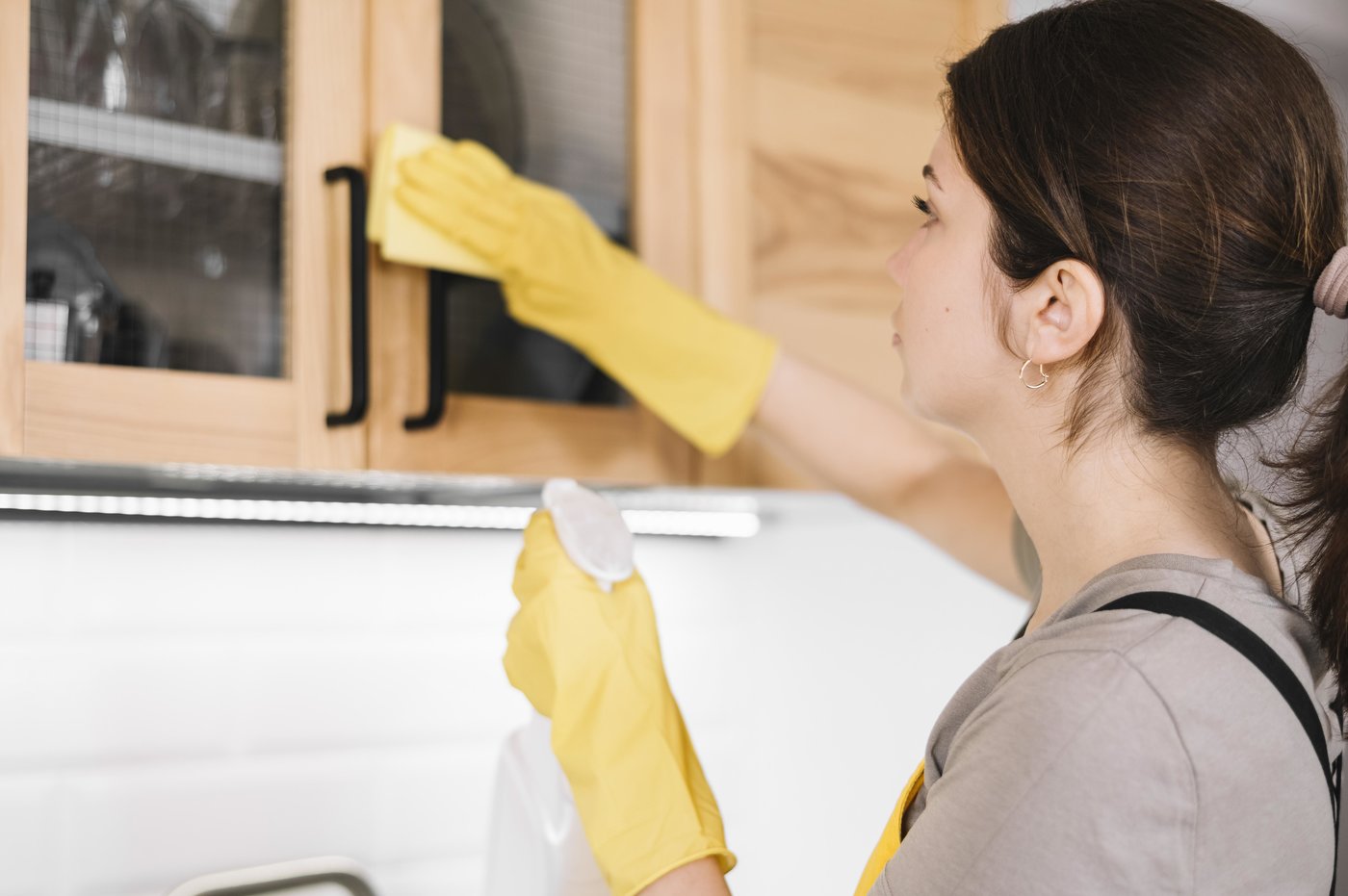Beautiful cabinets are one of the hallmarks of a sleek, attractive, well-designed kitchen. A clean set of cabinets speaks volumes about your kitchen, making the whole kitchen look cleaner, brighter and more inviting. However, sometimes, keeping those cabinets looking clean and beautiful can be a challenge. As grease, dirt, fingerprints and food particles build up over time, they can get stubbornly stuck onto your cabinets and be difficult to remove.
When cleaning cabinets, be sure to be thorough and get the sponge or washcloth into the hinges, around the handles and into any other nooks and crannies of the cabinets. Also remember that the interiors of cabinets need to be cleaned just like the exteriors. Every couple
months, remove all the food, plates, or containers from the inside of the cabinets and wipe down the inner shelves with disinfectant wipes to remove excess bacteria or food particles.
Of course, the more often you clean your cabinets, the less debris will add up and the easier they will be to clean. Here are some tips, tricks and how-to advice on how to clean your kitchen cabinets and keep them looking brand new!
How to Clean Wood Cabinets
Wood cabinets are tricky to keep clean. They get dirty quickly and can soon start to look old and faded as fingerprints, dust, grease and other food debris builds up over time. Depending on how dirty your cabinets are and how stubborn any stains are, you can use several different materials to clean wooden cabinets effectively.
Regardless of what you use to clean a wooden cabinet, always test the cleaner on a small, non-noticeable area before using it on all the cabinets to be sure it is not discoloring the cabinets or ruining the finish. Also, when cleaning wooden cabinets be sure never to use steel wool, scouring pads or any other abrasive sponges to scrub them, use only soft sponges or towels.
How to Clean Wood Cabinets with an Oil-Soap Wood Cleaner
This is probably the most effective way to clean wood cabinets. Oil-soap wood cleaners are specifically calibrated to remove debris from wooden surfaces without damaging the polish or finish while leaving behind a shine and a fresh, bright scent. These cleaners have drying oils that dry and form a hard, protective layer on the wood. You can purchase these cleaners very cheap at your local hardware or grocery store.
Here’s how to use these cleaners to clean your cabinets:
- Spray the wood cleaner liberally on the wooden cabinets. Let sit for 10 minutes.
- Wipe off the cleaner with a damp, hot towel to lift off grease and dirt.
- Dry cabinets completely.
How to Clean Wood Cabinets with Dish Soap
Dish soap effectively cuts through grease and is a cheap, easy product that you already have on hand, so it’s great for cleaning wooden cabinets.
To clean:
- Mix one part grease-cutting dish soap with two parts very hot water.
- Dip a soft sponge into hot water and scrub the cabinets with the sponge to remove grease and dirt.
- Dry cabinets completely.
Methods to Avoid When Cleaning Wood Cabinets

When cleaning wood cabinets you should avoid using:
- Vinegar: Some people online will suggest using vinegar to clean wood cabinets. Vinegar is a great disinfectant, but it can ruin the woods’ finish as it is an acid.
- Olive Oil and Baking Soda: This is a popular online method for cleaning wood cabinets as the olive oil provides a shine afterward. However, it can be very detrimental to the wood as the olive oil does not dry, it sits softly on the surface where it collects dust and can begin to spoil the wood.
How to Clean Metal Cabinets
Keeping metal cabinets clean is a little bit easier than keeping some other cabinets clean. Metal cabinets don’t absorb grease the same way that wood cabinets do and metal cabinets are naturally very strong and durable. Clean metal cabinets with the steps below, depending on how dirty your metal cabinets are and how deeply you want to clean them, you may or may not need to take all the steps:
- Start with just dusting the cabinets with a duster. Removing any dirt or dust from the surface of the cabinets first will make the cleaning easier later after liquid is applied. After dusting, you may feel that the cabinets are clean enough without taking the next steps.
- Mix one part grease-cutting dish soap with two parts very hot water. Dip a soft sponge into the hot, soapy water and scrub the cabinets to remove any grease or food debris. Start at the top of the cabinets and work your way down. After scrubbing, wipe the cabinets down with a damp towel to remove any suds then dry completely. For most metal cabinets, the first two steps will be enough to make for clean, shiny cabinets.
- Remove any rusty spots with steel wool and rubbing alcohol. One challenge that metal cabinets can present is collecting rust. If there are rusty spots on the cabinets or any other dirty spots that won’t come off with soap and water, apply a little rubbing alcohol to a towel and rub onto any dirty or rusty spots. Then, use some extra-fine steel wool to gently scrub off any spots. Avoid using coarse steel wool as it can scratch the surface of the cabinets.
- Finish with car wax. Finishing metal cabinets with car wax can provide it with a bright, radiant shine, helping them look brand new. Simply apply a thin layer of car wax onto the cabinets with a light cloth. Be sure that the room is well ventilated while applying the wax and apply the wax only on the outside of the cabinets in places where no food, plates or cutlery will be placed.
How to Clean Plastic Cabinets
Plastic cabinets are relatively easy to keep clean and hold up well to many cleaning methods. As plastic cabinets have no finish, they can hold up better to cleaners such as vinegar. To properly clean your plastic cabinets, follow these steps:
- Dust outside of the cabinets with a dry duster. You would be shocked at how much debris a simple dusting can remove. Dusting regularly can help reduce the need to deep clean plastic cabinets more often.
- Soak a soft sponge in grease-cutting dish soap with hot water and thoroughly scrub down the cabinets’ surface. The dish soap should lift any grease and dirt off of the cabinets.
- Wipe the cabinets down with a damp washcloth. Dry cabinets thoroughly.
- If your plastic cabinets are particularly greasy or have stubborn stains, mix together 2 parts warm water and 1 part white vinegar. Soak a washcloth in the solution and use it to wipe down the cabinets to lift any stuck-on grease or remaining stains.
How to Clean Painted Cabinets
Painted cabinets can be a little delicate. Cabinet paint is naturally tough, but harsh cleaning solutions or abrasive materials like steel wool or scouring pads can damage the paint. As with wood cabinets, always test your cleaning solution on a small area of the cabinet before applying it to the whole of the cabinets.
As with any other cabinets, the best way to keep painted cabinets clean is to wipe them down with a damp, soft cloth after every use. To perform a deeper clean on painted cabinets, take the following steps:
- Soak a washcloth in hot water with grease-cutting dish soap. Wipe painted cabinets down with washcloth. Repeat as many times as necessary to lift grease, dirt and dust from the surface.
- Wipe cabinets down with a damp washcloth, dry thoroughly.
- If your plastic, painted cabinets have persisting stains, mix together 2 parts warm water and 1 part white vinegar. Soak a washcloth in the solution and use it to wipe down the cabinets and lift any stuck on grease.
Image credit: Freepik

